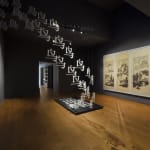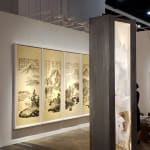-
作品
Xu Bing 徐冰
Suzhou Landscripts 苏州文字写生, 2003-2013Lithograph print in two colors from 35 plates on Entrada Natural Rag paper 35块板双色石版印刷,自然碎布纸86 5/8 x 34 1/4 in x 4 panels
220 x 87 cm x 4 panelsEP 1/2Copyright The ArtistFurther images
I used my method to copy four hanging scrolls from the Suzhou Museum. The four paintings that I chose are themselves works based on earlier paintings, something that is made...I used my method to copy four hanging scrolls from the Suzhou Museum. The four paintings that I chose are themselves works based on earlier paintings, something that is made apparent in their titles. "Plagiarism" does not exist in traditional Chinese culture. Good poetry emphasizes use of the "canon," the brilliant poetry of earlier generations. If a good painting possesses "classical" qualities, it must reflect the brushwork of the ancients. Chinese painting emphasizes "paper copying paper," and through these symbolized brushstrokes, it is passed on from generation to generation. The Mustard Seed Garden Manual of Painting, China’s most famous work of art instruction, compiles the brushstrokes — mountain strokes, tree strokes, rock strokes — from paintings of old. It is a dictionary. Students need only memorize the "radicals" to express everything existing in this world. In China, calligraphy and painting are a single action. Painting a mountain is writing the character "mountain". The Character "mountain" is the concept of "mountain", and the pith of a "mountain" and also a copy of the image "mountain" and how it has evolved. These four works nakedly exhibit and explore this tradition. Work of the Chinese literati are born from feelings that develop between friends, over time, at gatherings and outings. This group of prints, drafted over a period of ten years, are a record of a friendship.
September third, two thousand and eleven, Chang Chun Xu Bing.
我用自己的方法临摹苏州博物馆的四幅卷轴画。所选的这四幅画也都追摹更早的作品,摹仿意图在标题中已很明晰。“抄袭”一词在中国传统文化中并不存在。好诗歌会强调对典故的运用,这是古往今来延续的传统。如果一幅好的绘画具有古典特质,它肯定反映了古人的用笔。中国绘画强调纸抄纸,通过这些象征意义的笔触世代传承。芥子园画谱是中国最著名的经典范本,包括古人画山、树、石的各种笔法。凭借这本画谱,学画者只需将各种表现手法默记于心。在中国文化中,书画同源。画山即写山。“山”字代表山的概念和山的核心,字形得自山的形象及其演变。这四幅作品展现并探索这一传统。中国文人画作品发韧于友人之间的情谊,在文化雅集、访胜纪游中日久弥坚。这组作品历时十年,便是友谊的凭证。
2011 年,九月三日,长春徐冰。








